Australia has some of the most amazing and unique native plants of anywhere in the world. Our natural assets set us apart from the pack, and the plants available to us are some of the toughest and easiest to grow.
Need a stunning looking plant that won’t mind if you forget to water it, or one that doesn’t need any TLC like fertilising and pruning? Well then keep on reading, because there is most definitely an Australian native that will tick all your boxes!
Here is a super simple guide to using Australian native plants in your home garden.
More...
Australian Native Plants Guide

The number one reason most people grow natives in their home garden, is because they’re obviously so well suited to our Australian climate and conditions.
The majority of Australia experiences long dry spells, and has pretty poor quality soil, yet we have forests and grass lands full of amazing colourful, fragrant and vibrant species.
This is because most of our natives have evolved to survive in these conditions that most others would not. This is great for us gardeners, because it makes our job so much easier!
Drought tolerant plants that don’t need to be drowned in water every summers day, and plants that can go a lifetime with virtually no fertlising or prunning; how can you say no to that!
Using Australian natives in your garden are also better for your local environment. Not only will they provide habitat and food for native birds, animals, and insects, which will boost the overall ecology in your area, the reduced use of irrigation and fertilisers will benefit your local waterways too!
Using less water to irrigate means more saved for important stuff, like drinking, and not using fertilisers means that less of this is likely to run down drains and into creeks and streams, which can cause invasive weed outbreaks and poison delicate aquatic communities.
Australian Native Bush Tucker
Australian natives are also a great source of food! The traditional owners of our country couldn’t just pop down to the supermarket to pick up their dinner, so they relied heavily on what was available around them.
There are a great deal of edible Australian natives that can easily be grown in your backyard. Many have medicinal benefits such as pennywort also known as ‘pharmacy in one herb’. Learn more about this plant here.
Next time you think about your veggie patch, consider doing some research into bush tucker plants, and try using some tougher Australian natives such as the Tetragonia tetragonioides, more commonly known as Warrigal greens suited to your area (and of course your tastes).
Tips for Growing Australian Natives

Consider the Climate for Your Plant
There’s not a lot of difficult tricks you need to know when you’re growing Australian natives, but a few things are worth noting. Climate is the most important consideration when using Australian native plants.
Unfortunately our vast continent has extremely diverse conditions, from tropical in the north, arid and dry in the middle, cool in the south, and all the coastal zones within them. This means that you really need to pick your plants to suit your conditions.


Get Your Free Guide:
Master Growing Australian Natives eBook
A Must Have Complete Guide for Every Australian Garden
Get Your Free Guide:
Master Growing Australian Natives eBook
A Must Have Complete Guide for Every Australian Garden
Things to consider are humidity, wind exposure, heat, frosts, and rainfall. Thankfully though, this won’t involve too much heavy research. Most nurseries will sell plants specific to the area they’re in, and most plant tags have all the basic information you need to know.
I’m not saying you can’t grow plants outside their normal climates, it just means you’ll need to work harder to simulate them, whether this be extra watering or growing them in a greenhouse.
All that extra work is too much hassle for some, but it can definitely be a rewarding endeavour.
Right Amount of Pruning
Pruning Australian natives should be kept to a minimum, with the exception of grasses and sedges. These you can cut back regularly into an architectural ball shape, or if you don’t mind a bit of an eyesore, cut straight to the ground.
For shrubs and small trees such as the finger lime tree, need regular pruning. You can prune them to shape (eg a lilly pilly hedge) as you need to, but try not to go too hard. Whilst Australian natives are tough, they can’t handle a pruning massacare.
Watering natives is also an important thing to consider. Even though many are drought tolerant, even the hardiest of plants will need some water, especially when you’ve just planted them.
Australian natives are also often the victim of over loving with too much water. A good rule of thumb is if its rained recently, don’t water. If it’s been dry and your plants look like they’re wilting, give them some water. Common sense will prevail here
Fertilising Australian Natives
Fertlising is a no no on most natives. These plants are used to our nutrient poor soils, so adding artifical nutrients can have a negative affect. At a stretch, using some specific native fertiliser can help kick on some plants, as can some soft organic compost or mulch spread onto the soil.
Growing Australian Natives Year Round

Australia is home to some of the most beautiful native flora in the world. The rare and unique qualities of the species that only grow in our little pocket of the planet have become highly sought after.
These unusual species of plant life dot our landscape, creating a stunning vista admired by gardening buffs and anyone with an appreciation for the majestic.
So how do you foster Australian natives in your own space? And more importantly, how can you help them thrive all year round? Creating a healthy native garden is easier than it may seem. We’ve compiled a few tips to help grow your natives.
Proper Plant Placement
Grouping the correct plants together aesthetically is one thing, but arranging plants in a fashion that helps them grow properly is another equally important factor. An example is planting coverage for afternoon sun, specifically for plants that require less arid conditions.
Another example could be constructing a water feature near plants that require more water so they benefit from the run off. Pockets of lawn tend to be chillier areas for plant life and ideal for cooler climate flora.
On the flip side, paved areas can be perfect for plants used to arid conditions; the radiant heat generated can create the perfect microclimate.
When working towards a native garden, divide your space into zones and create specific areas for your existing plants, and arrange accommodations to compliment any new arrivals.

Meeting Austalian Native Plants Growing Conditions
You can create a welcome environment for plants to grow, and locality is key. Plants indigenous to your area will always thrive if looked after, and going too far out of that “comfort zone” may end disastrously.
Keep your selection to flora that can cope with your weather conditions, stick to the correct soil type, and with a little patience you will get your desired result. Another thing you should be aware of is the wildlife in your area.
Your new garden may soon be home to buzzing bees and butterfly flurries; wonderful as it may seem, your natives may attract new animals, domestic pets as well.
Do your research when it comes to which plants you add to your garden, as an animal influx may not be what you are after. For example, hosting Grevillea or Lilly Pilly could invite possums and flying foxes, so be mindful of planting in communal areas.

Setting a Feeding Schedule
Natives don’t necessarily require special plant food or a complex soil blend. In most cases the flora just needs the environment to be accommodating to the natural growth cycles of the plant.
The majority of standard plant food on the market is adaptable enough for most native plants and there are even fertilisers specifically designed for native gardens. A great first step is determining what feeding schedule is required at what times of the year.
If you’d like a more eco-friendly alternative, natural fertilisers such as plant and animal matter provide a kinder, more organic way to feed your natives. Adding phosphate to your household compost can positively enrich the soil.
Remember when using compost to test the pH to determine if it’s mature enough to use; acid levels should equalise and the PH should be around 6-8 for good, mature compost.

Provide Enough Trimming
In the bush, native plants are subjected to Australia’s extreme conditions; this includes the threat of bushfires, floods, and even being eaten. It’s for these reasons our bush land is so dense and lush.
Natural regeneration occurs and the old is replaced by the new – this same theory should be applied to a native garden. A properly controlled and fed native garden will thrive and actually need to be cut back to continue to grow.
Trimming at the end of the fruiting life cycle means sustained growth during the non-fruiting period and bigger, healthier blooms when the plant produces again. Even a grevillea will bloom in all but the coldest climates if it’s properly looked after.
Types of Australian Native Plant Species

In general terms, we can break down the different types of native plant species into 3 groups; Ground covers; grasses and sedges; and shrubs and trees. Each group has different benefits and uses in the home garden, which you should consider before you go throwing them into your yard.
Australian Native Ground Covers and Climbers
As the name suggests, these are plants that grow along the ground or climb up things. Most ground covers grow on the top layer of the soil they sit on and have a large underground root network, though I personally also include prostrate varieties of species in this group (Plants that grow sideways rather than up).
Climbers can be trained up trees or walls. These are great for big bulky areas where you want to cover some space. Climbers like Hibbertia scandens and Hardenbergia are great colourful climbers that are super tough.
See our Hardenbergia growing guides for in-depth insights:
There are also several native Clematis species which can provide great smothering coverage with incredible white flowers.

When it comes to ground covers, I think Australian natives are some of the best out. Viola hederacea and Dichondra repens are great as lawn alternatives or planted amoungst pavers or stone walkways.
Pratia varieties and Wahlenbergia stricta are two other amazing ground cover with super cute little flowers.
There’s also the option for growing varieties of your favourite shrubs, like
These are best used as low flowering shrubs in the front of your gardens, so you can get the benefits, without blocking out everything behind.
Here are some popular native varieties worth considering:
Grevillea nudiflora
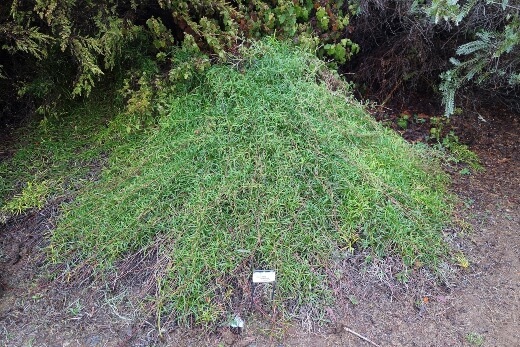
Source: commons.wikimedia.org
Grevillea nudiflora makes for an excellent ground cover or cascading plant. Featuring dense dark-green foliage and shapely, radiant red flowers, this plant grows to an ideal ground cover height of 0.3 to 1 metre tall.
Grevillea preissii ‘Sea Spray’
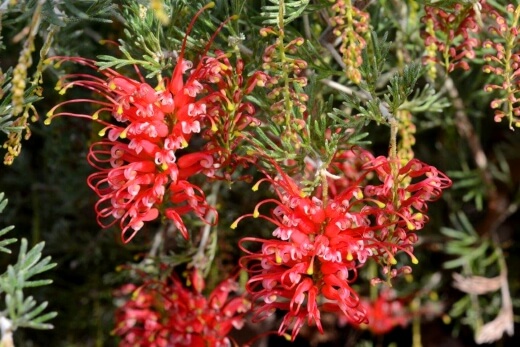
Source: bgpa.wa.gov.au
With wonderfully bright-red flowers and showy evergreen foliage, Grevillea preissii ‘Sea Spray’ produces unique tightly bunched flower clusters and grows up to 1 metre tall, making it a perfect native alternative for ground cover or as a climber.
Grevillea crithmifolia ‘Green Carpet’

Source: Commons.m.wikimedia.org
As the common name suggests, Grevillea crithmifolia ‘Green Carpet’ makes for a fantastic large groundcover plant. This evergreen shrub is loved for its intriguing foliage, profuse fragrant flowering and ideal growing habit.
Callistemon phoeniceus (Scarlet Bottlebrush)

Callistemons make for excellent climbing plants. Scarlet Bottlebrush grows up to 2 metres and produces bright red to pink flowers atop grey-green foliage.
Aussie Native Grasses and Sedges
Australia has some of the best native grass and sedge species available for use in your home garden. These can be clumping plants like Lomandra, Pennisetum and Themeda australis, which can fill in blank spaces, cover ugly spots, as well as add texture and colour to areas.
They can also include lawn alternatives, such as Microlaena stipoides which makes for an amazingly soft and drought tolerant lawn. Another fantastic lawn alternative worth considering is Sir Walter Buffalo Grass.
This is Australia’s number one buffalo turf variety due to the fact that it offers a superior soft and luscious feel underfoot with vibrant colour and hard-wearing qualities.
The last use for these type of plants is for filling in trouble spots in your garden. A lot of sedges and grases are super tough and can grow in areas that many other species can’t.
Ficinia nodosa, and Carex appressa are two great looking sedges that will handle the wettest problem spot in your garden. These are also great plants to use for some natural biofiltration of waterways you may have on your property.
They can help catch leaves and other junk before it washing down drains, and can even catch and help remove any bad chemicals or fertilisers before they get into the waterways. A lot of native grasses are now sold in sterile varities.
This is a good idea if you want a few feature spots in your garden, rather than a sprawling native meadow.
Australian Native Trees and Shrubs

This group is the one most home gardeners know and love. There are so many different native shrubs and trees available to buy, it’s really up to individual choice in what you want to achieve.
The only downside of some varieties is their relatively short life span (most shrubs will be lucky to get 20years old), and this needs to be considered when you’re planning your garden.
Don’t let this put you off at all, they’re still great garden choices, but doing some specific research will pay off here. Native shrubs like lilly pillies and westringias are great for fast growing hedges and screens.
Here are some honourable mentions for native hedge plants:
Westringia fruticosa ‘Coastal Rosemary’
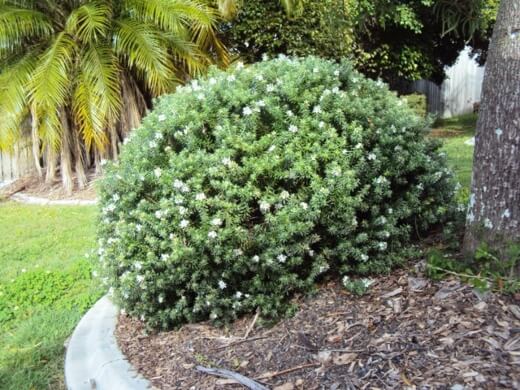
Source: antzplants.com.au
Westringia fruticosa ‘Coastal Rosemary’ is the most widely cultivated of its genus, being popularised for its excellent hedging and screening abilities. This variety features delicate white to pale lilac flowers and dense grey-green foliage. Grows 1 to 2 metres tall.
Syzygium australe ‘Creek Lilly Pilly’
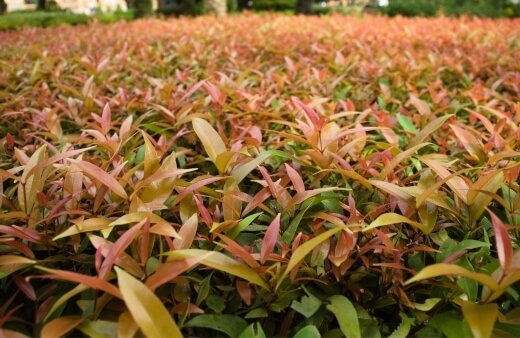
Widely cultivated for its hedging abilities, this variety grows as a small to medium-sized tree with bright new growth, beautiful clustering white flowers and edible bright-pink fruits.
Callistemon viminalis
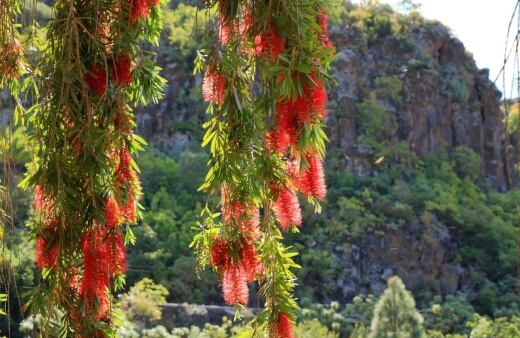
There are a few excellent viminalis cultivars available for hedging and screening. Ideal for small to medium hedges, these plants require little effort and offer showy displays of foliage and flowers.
Callistemon glaucus (Albany Bottlebrush)

A very popular variety of Callistemon for hedges or screens. Albany Bottlebrush grows to 2 metres and will thrive in cool or temperate conditions.
Elaeocarpus reticulatus (Blueberry Ash)
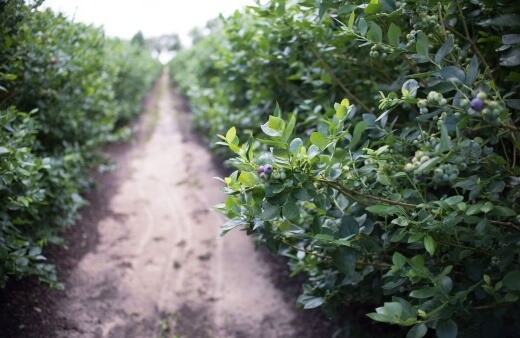
Perfect for more tropical regions, blueberry ash is another great hedge plant thanks to its year-round attractive growth and pretty flowers. Be sure to see our full, in-depth guide to Australian native hedge plants for more information on hedging plants.
Grevillea nudiflora, Callistemon phoeniceus, Mellaueca, Leptospermum, and Illawarra flame tree all have amazing flowers.
Larger trees such as Eucalyptus rhodantha, Angophora, and Corymbia are your traditional gum trees, and who can forget the amazing colour and smells of Acacias accuminata (wattles).
Trees and shrubs are also a really great source of bush tucker, like Macadamia and Syzygium that can grow in your backyard. What separates these shrubs from traditional exotic options are the other benefits these shrubs will bring, by providing shelter and food for native birds and animals.
Here are a few other popular bush tucker plants:
Using native shrubs can turn your backyard in a thriving community full of native colours and sounds!
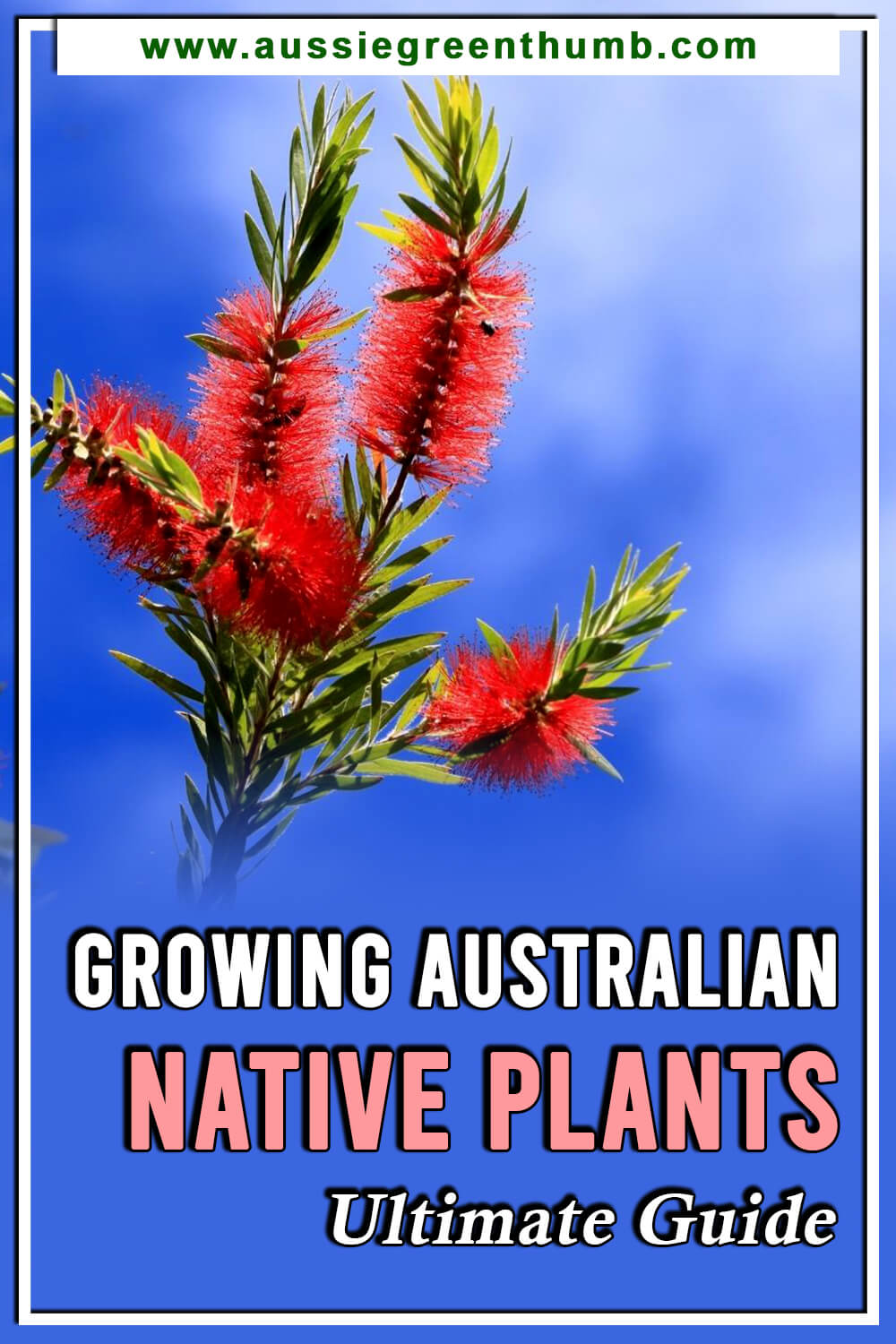
Wrapping Up Our Australian Native Plants Guide
For helpful tips and ideas, visit your local Botanical Gardens, as they are a valuable resource for more information. So you see it doesn’t have to be rocket science.
Growing Australian native plants that will produce all year round is pretty simple and can be very rewarding.
Published on June 10, 2022 by Nathan Schwartz
Last Updated on October 1, 2024





Hello,
Loving your website and inspired to try create an area of Aust Natives (incl proteaceae family) at home on 3 acres. (yellow box country, Creswick Vic 3363) The area I'm planning is approx 280-300 sq mtrs in full sun.
Ive not had much experience with Natives in particular the proteaceae family planting and soil preps. Ive mainly had experience with exotics but I want to succeed at growing Grevillea, Banksia, Hakea, Protea etc..
Im confused a bit about what to do with my soil, its heavy topsoil/clay which I've ripped to a depth of about 250-300mm all over. Its a fairly flat site (paddock grassed, cleared, unworked) but does have gentle slope. My idea is to raise the soil and improve with river sand with mounds like you describe in the book.
The existing soil is low pH 4.5-6.0 and very low in Phosphorus. It was packed down hard before I ripped with a single tyne rip on small back-hoe garden tractor. I'm wary/concerned of composts and soils to add which may be higher in phosphorus. Im currently looking for a river sand low in P and slightly alkaline to raise the overall pH.
Was thinking about 100-200mm of the sand over the top and rotary hoed in with heaps of gypsum. To me the soil doesn't look like 100% clay as its darker more like a topsoil in most areas but deeper down (50cm) its more solid orange clay.
How do I prepare best for my natives (Grevillea, Banksia, Hakea, Acacia, and may other Aust natives) planting? I do have a simple home test kit for Phosphorus, Thinking river sand as its low in P but unsure about amounts of compost as the test I've done on one sample came back as higher P levels than the sand.
Hoping you can help me as I'd like to plant them whilst the weather is cool. Happy to send in any pics if required? Look forward to any advice you may have and continuing to read your newsletters etc. Many thanks!
P.s I am a nurseryman but have no experience with Aust Natives and soil preps. Im nervous/hesitant about the phosphorus I guess..
Hi Brendan,
This sounds exciting. We’re always trying to encourage more native planting, but it can be hard. If you’ve got the passion and the space, then go for it. We’d love to help, and definitely keep in touch about progress.
Most useful natives – by which I mean those you’d want to grow at home – will grow well in Victoria. The milder climate makes them easier to manage. If you’re going to be growing them on scale, you should be able to grow some pretty spectacular shrubs without too much water either – especially if you’ve got a bit of clay in the soil to hold onto moisture through summer.
In terms of what you’ve already done, the cultivation will definitely make it easier to work, but you’re right that some sort of sand is needed. Not necessarily to do anything to the pH, but to make sure the soil stays workable, and that rooted shrubs are easy enough to rip up.
Gypsum won’t change the pH of soil, but it does add calcium, magnesium and sulphur (useful for crops, but not particularly important for shrubs). What it will do is make flowering more reliable. If you’re planning on growing in loose topsoil to pot on for sale, you should get some decent blooms which’ll make your plants more sellable.
Even in gardens over exposure to phosphorus can harm most natives (Grevillea and Banksia in particular) but adding iron back into the soil through iron sulphate in liquid form is a quick fix. The reason they hate phosphorus is because it inhibits iron uptake, but if you can offer iron when they need it you can usually manage that.
So basically, they do need compost, and they do need drainage, so finding that mix (especially on sandy orange clay like yours in Vic) is going to take a bit of trial and error. Cow manure is the lowest phosphorus you’ll get with readily available calcium and nitrogen, but it will also boost water retention, so you’ll definitely need the river sand to mix in so you’re not upsetting the drainage too.
If I were you, I’d start off by working 50:50 river sand and cow manure (the big benefit, even though there’s some risk, is that more nurseries will accept organic grown shrubs in the next few years, so the more likely you are to meet that goal, the more you’re gonna sell).
If you notice any sort of damage to the leaves (first signs are a soft discolouring – like a grey tinge) then flush the soil when it’s hot out, and then add liquid iron sulphate to balance everything out.
Beyond that, they should grow in those conditions with very little ongoing soil care.
Keep in touch though, because I’d love to keep an eye on what’s going on, and see how else we can help. It’s exciting when new projects like this happen, especially when it’s dedicated to natives, and more sustainable types of planting.
Best regards,
Gary Clarke
Hi Gary,
Many thanks for your comprehensive and terrific reply. Lots noted and used in this project.
We are well underway and most of the 400-500 plants are now planted.
Ive had lots of experience with the culture of exotics and selling some natives in the Nursery but this is all new to me having a native garden at home on our 5 acres. Looking fwd to watching it develop and the wildlife it might bring.
Hi Brendan,
I can only imagine the sort of wildlife it’s going to bring in. We always used to hear about projects like this from a perspective of habitat confusion (like birds were nesting but then the plants were staying young, but the reality is that these natives are a huge boost to pollinators that rely completely on natives, and swathes of mixed natives like this is an outstanding way to help them out while they’re growing.
Not to mention the benefit it could bring when they end up in their final homes and gardens!
Thanks for the update!
Best regards,
Gary Clarke